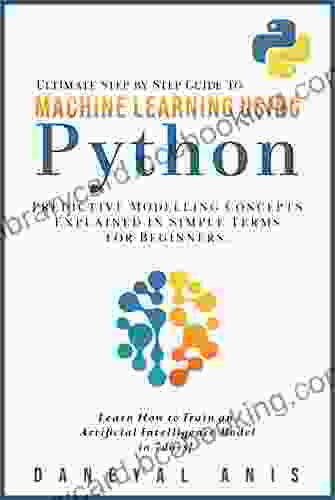Predictive Modelling Concepts Explained In Simple Terms For Beginners

: A Glimpse into the Future
In today's data-driven world, businesses and organizations are leveraging the incredible power of predictive modelling to gain a competitive edge. But what exactly is predictive modelling, and how can it benefit you? This comprehensive guide will walk you through the fundamental concepts of predictive modelling in simple terms, making it accessible to beginners of all levels.
4.3 out of 5
| Language | : | English |
| File size | : | 2363 KB |
| Text-to-Speech | : | Enabled |
| Screen Reader | : | Supported |
| Enhanced typesetting | : | Enabled |
| Print length | : | 70 pages |
| Lending | : | Enabled |
Simply put, predictive modelling is a technique used to create models that can predict future outcomes based on historical data. By analyzing patterns and relationships in existing data, these models can make informed predictions about what might happen in the future. From forecasting sales trends to predicting customer behavior, the applications of predictive modelling are vast and impactful.
Types of Predictive Modelling
There are various types of predictive modelling techniques, each suited to different types of problems. Here are some of the most common:
- Regression: Used to predict continuous outcomes, such as sales revenue or customer satisfaction. A regression model establishes a relationship between the input variables and the output variable, allowing for predictions within a continuous range.
- Classification: Used to predict categorical outcomes, such as whether a customer will churn or a loan application will be approved. A classification model assigns a probability to each possible category, enabling the prediction of the most likely outcome.
- Time Series: Used to predict future values of a time series, such as stock prices or website traffic. A time series model analyzes patterns and trends over time to make predictions about future values.
- Clustering: Used to identify groups of similar data points within a dataset. A clustering model finds patterns and similarities in the data, revealing hidden relationships and enabling the identification of customer segments or market niches.
Steps in Building a Predictive Model
Building a predictive model involves a systematic process that typically includes the following steps:
- Data Collection: Gather the relevant historical data that will serve as the foundation for your model.
- Data Cleaning and Preprocessing: Clean, transform, and prepare the data to ensure its quality and consistency.
- Model Selection: Choose the appropriate type of predictive modelling technique based on the problem you want to solve.
- Model Training: Train the model using the historical data, allowing it to learn the patterns and relationships within the data.
- Model Evaluation: Assess the performance of the model using various metrics to determine its accuracy and generalizability.
- Model Deployment: Implement the trained model into a production environment to make predictions on new data.
Applications of Predictive Modelling
Predictive modelling has a wide range of applications across various industries, including:
- Sales forecasting: Predicting future sales revenue to optimize inventory and marketing strategies.
- Customer behavior analysis: Understanding customer preferences, churn risk, and next best actions to enhance customer engagement and loyalty.
- Fraud detection: Identifying suspicious transactions and reducing financial losses.
- Risk assessment: Evaluating the risk associated with loans, investments, and insurance policies.
- Healthcare diagnosis and treatment: Predicting disease outcomes, identifying high-risk patients, and optimizing treatment plans.
Benefits of Predictive Modelling
By leveraging predictive modelling, businesses and organizations can unlock numerous benefits:
- Improved decision-making: Predictive models provide data-driven insights that enable informed decision-making, reducing uncertainty and improving outcomes.
- Enhanced competitiveness: By leveraging predictive analytics, businesses can gain a competitive edge by identifying opportunities, predicting trends, and optimizing strategies.
- Increased profitability: Predictive modelling helps businesses maximize revenue, optimize pricing, and reduce costs by predicting demand, forecasting sales, and identifying growth opportunities.
- Better customer experience: Predictive models empower businesses to understand customer behavior, personalize interactions, and deliver tailored experiences that increase customer satisfaction and loyalty.
- Reduced risks: Predictive analytics helps businesses mitigate risks, make informed decisions, and protect themselves from potential threats.
Predictive modelling is a powerful tool that can revolutionize the way businesses operate and make decisions. By understanding the fundamental concepts, techniques, and applications of predictive modelling, you can harness its potential and gain a competitive advantage in today's data-driven world. Whether you're a beginner looking to step into the field or an experienced professional seeking to expand your knowledge, this guide has provided you with a comprehensive overview of this transformative technology.
4.3 out of 5
| Language | : | English |
| File size | : | 2363 KB |
| Text-to-Speech | : | Enabled |
| Screen Reader | : | Supported |
| Enhanced typesetting | : | Enabled |
| Print length | : | 70 pages |
| Lending | : | Enabled |
Do you want to contribute by writing guest posts on this blog?
Please contact us and send us a resume of previous articles that you have written.
 Book
Book Novel
Novel Page
Page Chapter
Chapter Text
Text Story
Story Genre
Genre Reader
Reader Library
Library Paperback
Paperback E-book
E-book Magazine
Magazine Newspaper
Newspaper Paragraph
Paragraph Sentence
Sentence Bookmark
Bookmark Shelf
Shelf Glossary
Glossary Bibliography
Bibliography Foreword
Foreword Preface
Preface Synopsis
Synopsis Annotation
Annotation Footnote
Footnote Manuscript
Manuscript Scroll
Scroll Codex
Codex Tome
Tome Bestseller
Bestseller Classics
Classics Library card
Library card Narrative
Narrative Biography
Biography Autobiography
Autobiography Memoir
Memoir Reference
Reference Encyclopedia
Encyclopedia Colin Woodard
Colin Woodard Cory Weagant
Cory Weagant Craig Walls
Craig Walls Connie Dawson
Connie Dawson Cynthia Moss
Cynthia Moss Danica Davidson
Danica Davidson Claire Akin Mba
Claire Akin Mba Colleen Nelson
Colleen Nelson Cynthia Saltzman
Cynthia Saltzman Claudia Friddell
Claudia Friddell Daniel Barbarisi
Daniel Barbarisi Daniel Burleigh Parkhurst
Daniel Burleigh Parkhurst Cosmas Inyang
Cosmas Inyang Colin R Turner
Colin R Turner Daigo Umehara
Daigo Umehara Clive Glaser
Clive Glaser Dale Merrill
Dale Merrill Colin Campbell
Colin Campbell Corey Robin
Corey Robin Dale Lorna Jacobsen
Dale Lorna Jacobsen
Light bulbAdvertise smarter! Our strategic ad space ensures maximum exposure. Reserve your spot today!

 Craig BlairUnleash Your Inner Cheerleader with The Chance Creek Cheerleaders Cookbook: A...
Craig BlairUnleash Your Inner Cheerleader with The Chance Creek Cheerleaders Cookbook: A... Evan SimmonsFollow ·17.9k
Evan SimmonsFollow ·17.9k Leon FosterFollow ·2.3k
Leon FosterFollow ·2.3k Herb SimmonsFollow ·5.9k
Herb SimmonsFollow ·5.9k Milton BellFollow ·19.2k
Milton BellFollow ·19.2k Howard PowellFollow ·12.6k
Howard PowellFollow ·12.6k John KeatsFollow ·7.6k
John KeatsFollow ·7.6k Hamilton BellFollow ·4.2k
Hamilton BellFollow ·4.2k Octavio PazFollow ·19k
Octavio PazFollow ·19k

 Donald Ward
Donald WardVeteran Investment Advisor Reflects On Money
Unlocking Financial Wisdom...

 Fernando Pessoa
Fernando PessoaUnlock the Secrets of Value Investing with "University of...
In the realm of investing, there stands an...

 Jorge Luis Borges
Jorge Luis BorgesMaster Spanish Vocabulary with Ap Spanish Flashcards...
Are you eager to expand your Spanish...

 Roger Turner
Roger TurnerPlay Like a Pro: The Ultimate Guide to Becoming a Master...
Are you ready to...
4.3 out of 5
| Language | : | English |
| File size | : | 2363 KB |
| Text-to-Speech | : | Enabled |
| Screen Reader | : | Supported |
| Enhanced typesetting | : | Enabled |
| Print length | : | 70 pages |
| Lending | : | Enabled |













